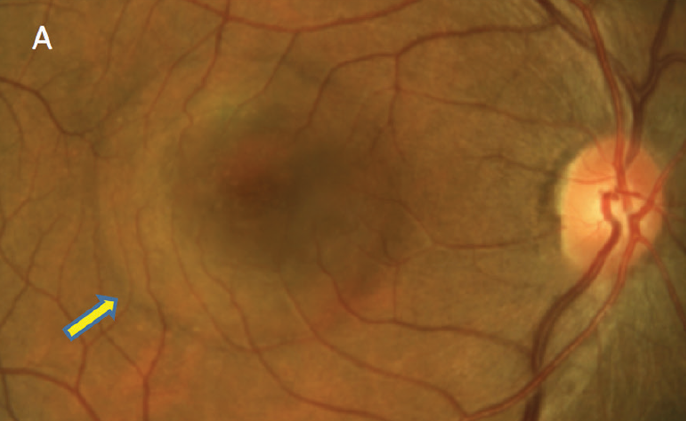 |
|
Patients in this study with complex CSC had a thicker choroid and thinner central retina compared with those with the simple type. Photo: Mohammad Rafieetary, OD. Click image to enlarge. |
Previously, central serous chorioretinopathy (CSC) had been classified as either acute or chronic depending on disease duration, but thresholds vary from study to study. A recent alternative classification system categorizes the disease as either simple or complex based on whether the retinal pigment epithelium (RPE) alteration region is greater than two disc areas. A third atypical type of CSC was classified to include bullous variant, RPE tear and association with other retinal diseases. A team of researchers used the revised system in a new study to investigate the clinical and genetic characteristics of simple vs. complex CSC.
The study evaluated 319 patients with idiopathic CSC. Disease type was determined based on the presence or absence of retinal pigment alterations greater than two disc areas in either eye. Among the cohort, 53 patients (16.6%) had the complex type based on the new classification system criteria.
Complex CSC was seen exclusively in males (100%), and the majority of patients with the simple type were also male (79%). The researchers explained in their paper, “Although we cannot conclude whether this result is due to differences in RPE vulnerability or choroidal thickness between the sexes, female hormones might have a protective effect against RPE damage.”
The team also found that compared with patients with the simple type, those with the complex type had a significantly higher proportion of bilateral involvement (75.5% vs. 17.7%) and descending tract(s) (83% vs. 0%). Complex CSC patients also had a thicker choroid (425µm vs. 382µm) and thinner central retina (274µm vs. 337µm) compared with simple CSC patients.
Blood samples were collected from each participant to genotype CFH variants rs800292 and rs1329428. The researchers reported that the “risk allele frequencies of both variants were significantly higher in the complex vs. simple type” (61.3% vs. 48.7% and 65.1% vs. 54.3%). Based on these results, they concluded, “The risk allele of the CFH gene is associated with an RPE alteration greater than a two-disc area, including patchy atrophy and descending tract(s). Although this study was cross-sectional, genotyping these variants might be useful for predicting RPE atrophy development and enlargement.”
The data from this study demonstrates distinct differences between complex and simple CSC, which may help direct future research on predictors and risk factors of both disease types.
Yoneyama S, Fukui A, Sakurada Y, et al. Distinct characteristics of simple versus complex central serous chorioretinopathy. Retina. December 7, 2022. [Epub ahead of print]. |

